|
CHAPTER VIII.
TRYING IT AGAIN.
The True Story of Christopher Columbus, Called the Great Admiral | ||
8.
CHAPTER VIII.
TRYING IT AGAIN.
DO you not think Columbus must have felt very fine as he sailed out of Cadiz Harbor on his second voyage to the West? It was just about a year before, you know, that his feeble fleet of three little ships sailed from Palos port. His hundred sailors hated to go; his friends were few; everybody else said he was crazy; his success was very doubtful. Now, as he stood on the high quarter-deck of his big flag-ship, the Maria Galante, he was a great man. By appointment of his king and queen he was "Admiral of the Ocean Seas" and "Viceroy of the Indies." He had servants, to do as he directed; he had supreme command over the seventeen ships of his fleet, large and small; fifteen hundred men joyfully crowded his decks, while thousands left at home wished that they might go with him, too. He had soldiers and sailors, horsemen and footmen; his ships were filled with all the things necessary for trading with the Indians and the great merchants of Cathay, and for building the homes of those who wished to live in the lands beyond the sea.
Everything looked so well and everybody was so full of
This was to be a hunt for gold. And so sure of success
was Columbus that he promised the king and queen of

THE HARBOR OF CADIZ.
[Description:
Drawing of the town and harbor of Cadiz.
]
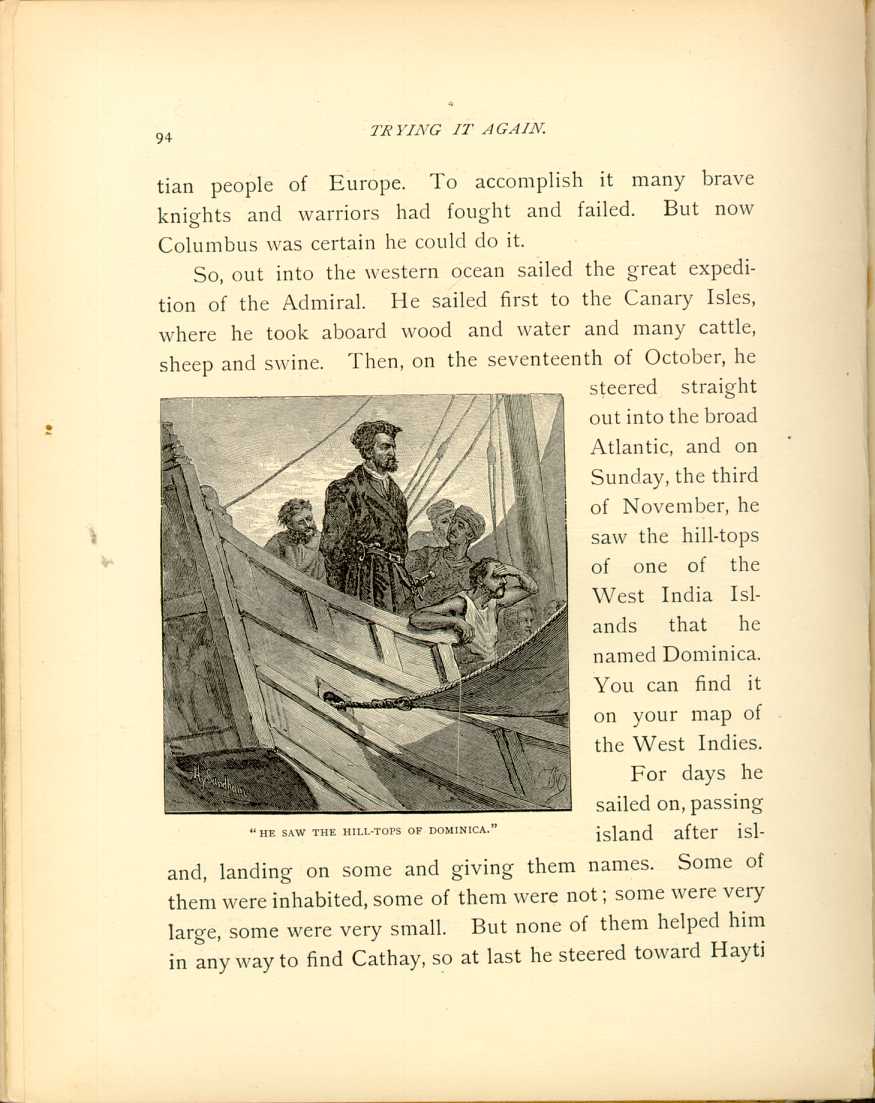
"HE SAW THE HILL-TOPS OF DOMINICA"
[Description: Drawing of Columbus standing on the deck of his ship with several men at his side. ]So, out into the western ocean sailed the great expedition of the Admiral. He sailed first to the Canary Isles, where he took aboard wood and water and many cattle, sheep and swine. Then, on the seventeenth of October, he steered straight out into the broad Atlantic, and on Sunday, the third of November, he saw the hill-tops of one of the West India Islands that he named Dominica. You can find it on your map of the West Indies.
For days he sailed on, passing island after island, landing on some and giving them names. Some of them were inhabited, some of them were not; some were very large, some were very small. But none of them helped him in any way to find Cathay, so at last he steered toward Hayti
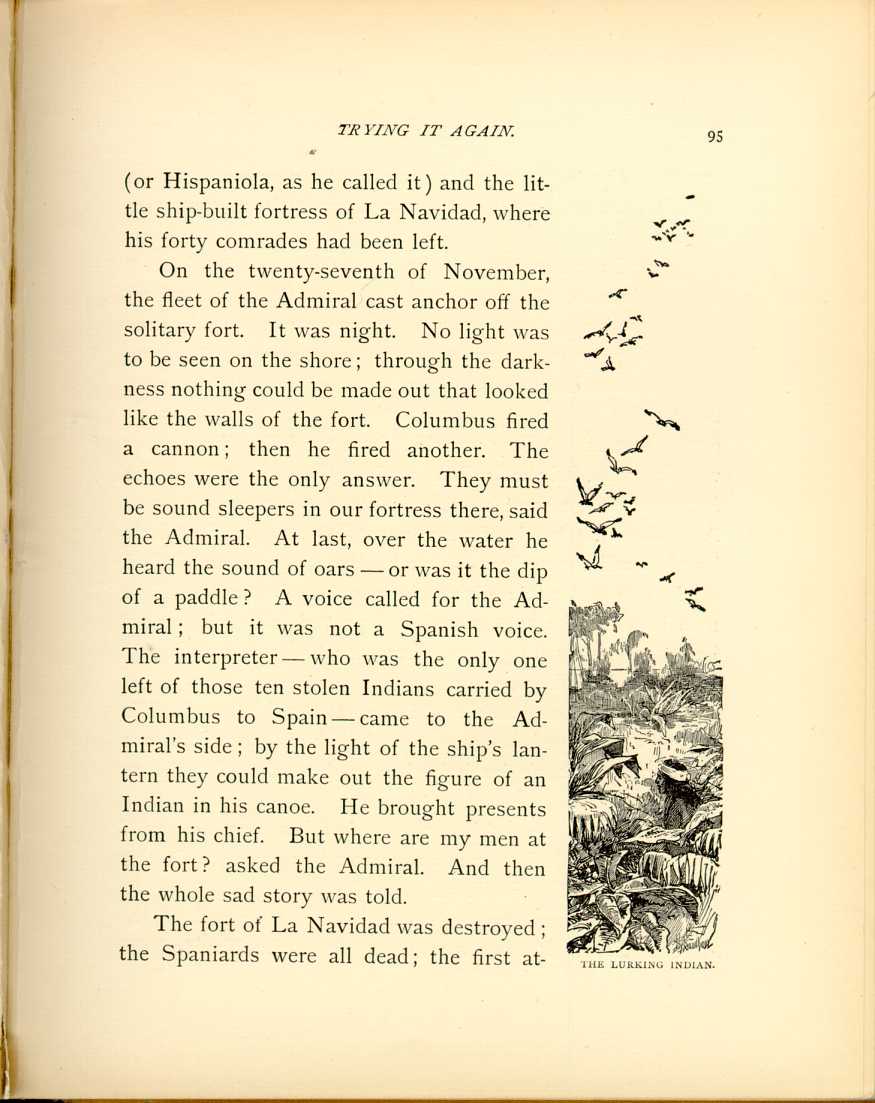
THE LURKING INDIAN
[Description: Drawing of a Native American figure in the midst of a tropical forest. A flock of birds fly overhead. ]On the twenty-seventh of November, the fleet of the Admiral cast anchor off the solitary fort. It was night. No light was to be seen on the shore; through the darkness nothing could be made out that looked like the walls of the fort. Columbus fired a cannon; then he fired another. The echoes were the only answer. They must be sound sleepers in our fortress there, said the Admiral. At last, over the water he heard the sound of oars—or was it the dip of a paddle? A voice called for the Admiral; but it was not a Spanish voice. The interpreter—who was the only one left of those ten stolen Indians carried by Columbus to Spain—came to the Admiral's side; by the light of the ship's lantern they could make out the figure of an Indian in his canoe. He brought presents from his chief. But where are my men at the fort? asked the Admiral. And then the whole sad story was told.
The fort of La Navidad was destroyed; the Spaniards were all dead; the first attempt
After Columbus had left them, the forty men in the fort did not do as he told them or as they had solemnly promised. They were lazy; they were rough; they treated the Indians badly; they quarreled among themselves; some of them ran off to live in the woods. Then sickness came; there were two "sides," each one jealous of the other; the Indians became enemies. A fiery war-chief from the hills, whose name was Caonabo, led the Indians against the white men. The fort and village were surprised, surrounded and destroyed. And the little band of "conquerors"—as the Spaniards loved to call themselves—was itself conquered and killed.
It was a terrible disappointment to Columbus. The men in whom he had trusted had proved false. The gold he had told them to get together they had not even found. His plans had all gone wrong.
But Columbus was not the man to stay defeated. His fort was destroyed, his men were killed, his settlement was a failure. It can't be helped now, he said. I will try again.
This time he would not only build a fort, he would build a city. He had men and material enough to do this and to do it well. So he set to work.
But the place where he had built from the wreck of the unlucky Santa Maria his unlucky fort of La Navidad did
He found here a good harbor for ships, a good place on the rocks
for a fort, and good land for gardens. Here Columbus laid out his new
town, and called it after his friend the queen of Spain, the city of
Isabella.
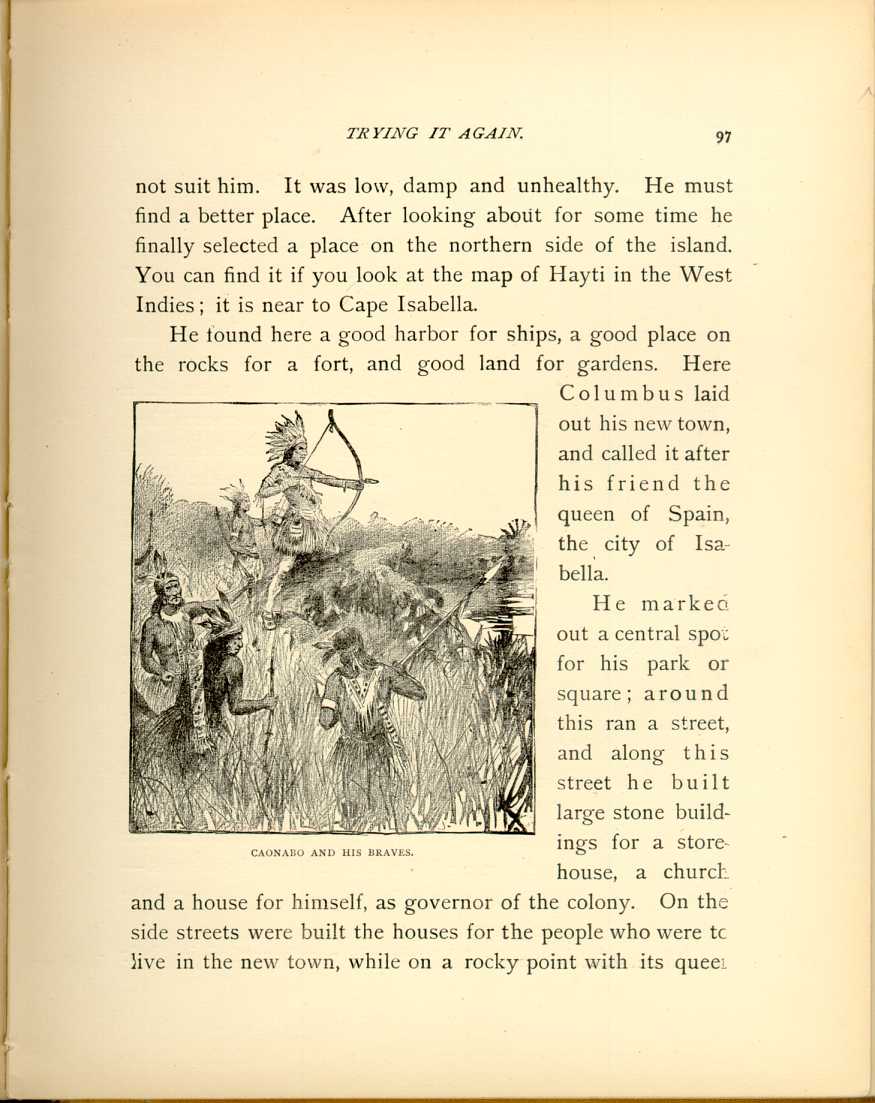
CAONABO AND HIS BRAVES.
[Description:
Drawing of Caonabo and several other Native Americans with bows and
arrows and spears in their hands.
]
He marked out a central spot for his park or square; around this ran a street, and along this street he built large stone buildings for a storehouse, a church and a house for himself, as governor of the colony. On the side streets were built the houses for the people who were to live in the new town, while on a rocky point with its queer
You must know that there are some very wise and very bright
people who do not agree to this. They say that nearly five hundred years
before Columbus landed, a Norwegian prince or viking, whose name was
Leif Ericsson, had built on the banks of the beautiful Charles River,
some twelve miles from Boston, a city which he called Norumbega.
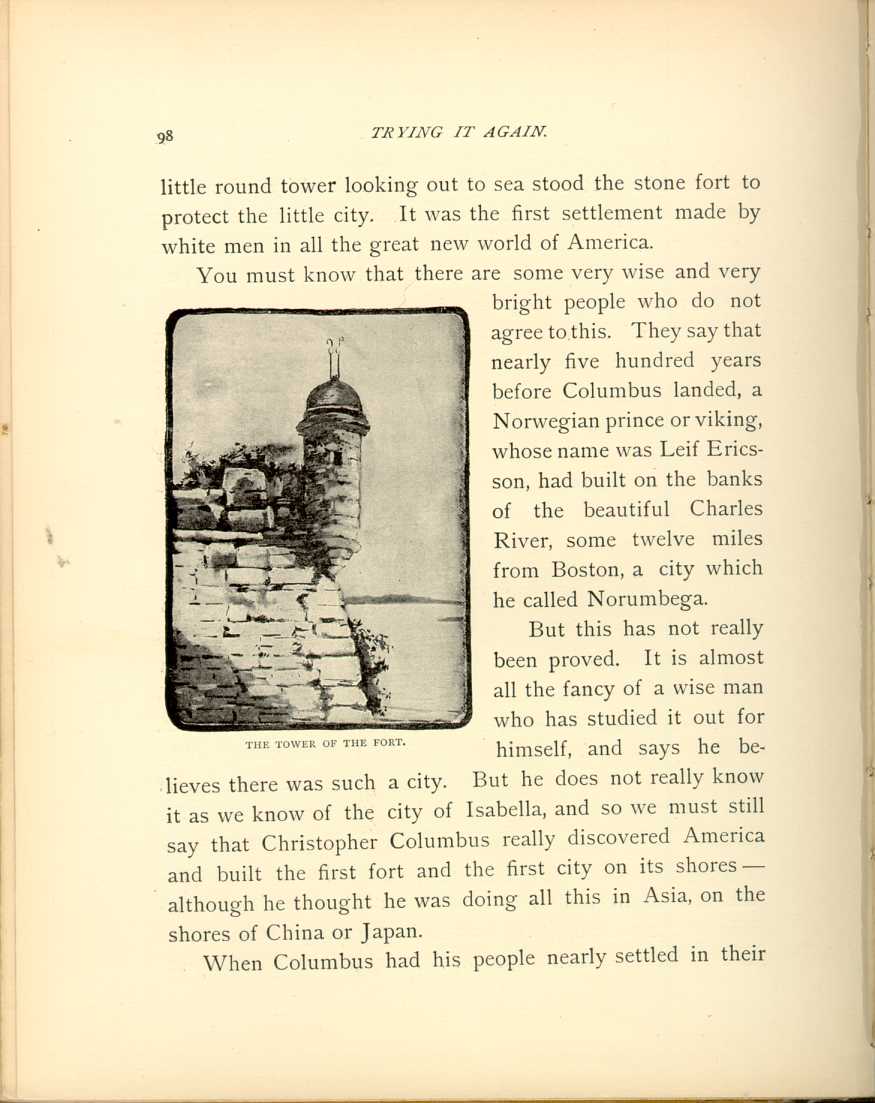
THE TOWER OF THE FORT.
[Description:
Drawing of a stone tower.
]
But this has not really been proved. It is almost all the fancy of a wise man who has studied it out for himself, and says he believes there was such a city. But he does not really know it as we know of the city of Isabella, and so we must still say that Christopher Columbus really discovered America and built the first fort and the first city on its shores—although he thought he was doing all this in Asia, on the shores of China or Japan.
When Columbus had his people nearly settled in their

THE RUINS OF ISABELLA.
(The first settlement made by white men in all the great new world of
America.)
[Description:
Drawing of the ruins of Isabella.
]
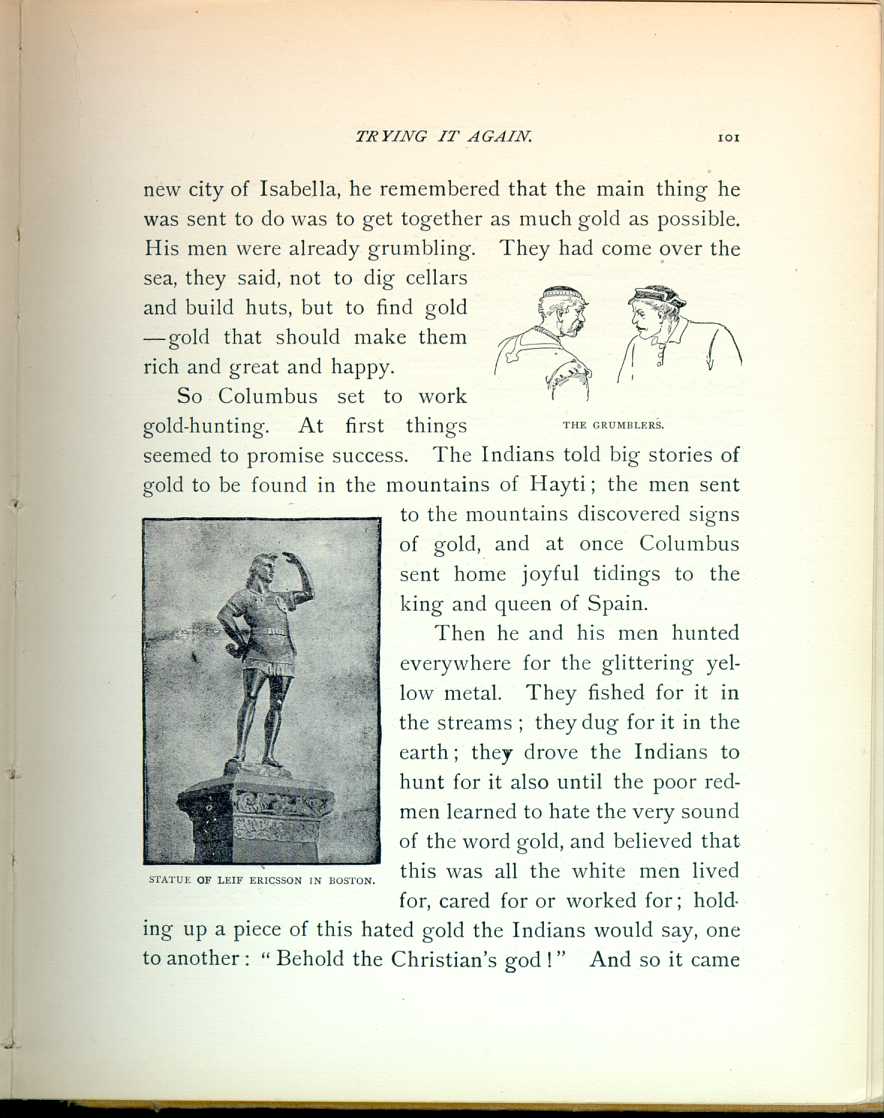
THE GRUMBLERS.
and
STATUE OF LEIF ERICSSON IN BOSTON.
[Description:
Drawing of two grumbing men and a photograph of a statue of Leif Ericsson.
]
So Columbus set to work gold-hunting. At first things seemed to promise success. The Indians told big stories of gold to be found in the mountains of Hayti; the men sent to the mountains discovered signs of gold, and at once Columbus sent home joyful tidings to the king and queen of Spain.
Then he and his men hunted everywhere for the glittering yellow metal. They fished for it in the streams; they dug for it in the earth; they drove the Indians to hunt for it also until the poor redmen learned to hate the very sound of the word gold, and believed that this was all the white men lived for, cared for or worked for; holding up a piece of this hated gold the Indians would say, one to another: "Behold the Christian's god!" And so it came
On the thirteenth of January, 1494, Columbus sent back to Spain twelve of his seventeen ships. He did not send back in them to the king, and queen, the gold he had promised. He sent back the letters that promised gold; he sent back as prisoners for punishment some of the most discontented and quarrelsome of his colonists; and, worst of all, he sent to the king and queen a note asking, them to permit him to send to Spain all the Indians he could catch, to be sold as slaves. He said that by doing this they could make "good Christians" of the Indians, while the money that came from selling the natives would buy cattle for the colony and leave some money for the royal money-chests.
It is not pleasant to think this of so great a man as Columbus. But it is true, and he is really the man who, started the slave-trade in America. Of course things were very different in his time from what they are to-day, and people did not think so badly of this horrible business. But some good men did, and spoke out boldly against it. What they said was not of much use, however, and slavery was started in the new world. And from that act of Columbus came much sorrow and trouble for the land he found. Even the great war between the northern and southern sections of
So the twelve ships sailed back to Spain, and Columbus, with his five remaining ships, his soldiers and his colonists, remained in the new city of Isabella to keep up the hunt for gold or to become farmers in the new world.
|
CHAPTER VIII.
TRYING IT AGAIN.
The True Story of Christopher Columbus, Called the Great Admiral | ||